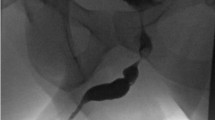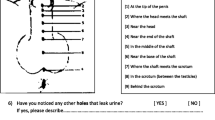Abstract
Hypospadias surgery is one of the most difficult areas in pediatric urology and has been characterized by constant evolution. Some of the surgical techniques proposed in the past are now considered inadequate because of an unacceptable complication rate or poor functional and aesthetic results. The key for assessing a surgical technique (or a particular aspect of it) is continuous evaluation through long-term patient follow-up. We present the medical records of 693 patients over 10 years, all operated on by the same surgeon (the first author), with a minimum of 12 months of follow-up. The overall complication rate was 6.49% (45 cases). The most frequent complication was urethral fistula, occurring in 28 patients (62%). Other complications were redo for penile deformity or meatal retraction (eight cases, 17%), megalourethra (five cases, 11%), meatal stenosis (two cases, 4%), and urethral stenosis (two cases, 4%). We have noticed an increased rate of complications in patients older than 12 months (18.7% vs. 3.4% in patients younger than 12 months) and in patients operated on at puberty or later (15%). We have seen no difference in the complication rate related to the type of hospitalisation (day surgery vs. traditional hospitalisation). Regarding the relationship between the type of complication and the type of defect, except for the constant presence of fistulae, a high incidence of megalourethra was seen in proximal defects treated with preputial graft. The sexual outcomes of 32 subjects are presented. Multiple factors influence the final result, but the most important factor is the surgeon’s own experience. Knowledge of different techniques and delicate tissue handling are essential. Our experience shows that the ideal age for surgery is 8–12 months. Owing to a minimal emotional impact on the child and to a reasonable use of economical resources, we consider day surgery the ideal way to treat these patients whenever possible. Even in the absence of complications, follow-up must be continued at least until the end of puberty and, when possible, up to the patient’s sexual debut. Adequate interviews with the patients (principally teenagers and young adults) are the best way to evaluate their need for psychological support.
Similar content being viewed by others
References
Ferro F, Zaccara A, Spagnoli A, Lucchetti MC, Capitanucci ML, Villa M (2002) Skin graft for 2-stage treatment of severe hypospadias: back to the future? J Urol 168:1730–1733
Bracka A (1989) A long-term view of hypospadias. Br J Plast Surg 42:251–255
de Vries JDM (1995) Hypospadias. Curr Opin Urol 5:133–135
Sorber M, Feitz WFJ, de Vries JDM (1997) Short and mid-term outcome of different types of one-stage hypospadias corrections. Eur Urol 32:475–479
Hodgson NB (1970) A one stage hypospadias repair. J Urol 104:281–283
Shondfeld WA. Primary and secondary sexual characteristics (1943) Am J Dis Child 65:535–549
American Academy of Pediatrics (1996) Timing of elective surgery on the genitalia of male children with particular reference to the risks, benefits and psychological effects of surgery and anesthesia. Pediatrics 97:590–594
Mondet F, Johanet S, Larroquet M, Van Glabeke E, Audry G (1999) Repair of anterior hypospadias with transurethral vescical catheter: comparision of ambulatory surgery with the “between 2 diapers” catheter and traditional hospitalization. Prog Urol 9:107–111
Siegel AL, Snyder HM, Duckett JW (1986) Day urological surgery: techniques for a successful and cost-effective practice. J Urol 136:879–881
Wallon P, Saint-Supery G, Bucco P (1984) Prepuce plastic surgery, known as the Lille operation, in distal hypospadias. Apropos of 138 cases. Chir Pediatr 25:53–57
Van Dorpe EJ (1987) Correction of distal hypospadias with reconstruction of the preputium. Plast Reconstr Surg 80:290–293
Aho MO, Tammela OKT, Tammela TLJ (1997) Aspects of adult satisfaction with the result of surgery for hypospadias performed in childhood. Eur Urol 32:218–222
Mureau MA, Slijper FM, van der Meulen JC, Verhulst FC, Slob A (1995) Psychosexual adjustment of men who underwent hypospadias repair: a norm-related study. J Urol 154:1351–1355
Author information
Authors and Affiliations
Corresponding author
Rights and permissions
About this article
Cite this article
Marrocco, G., Vallasciani, S., Fiocca, G. et al. Hypospadias surgery: a 10-year review. Ped Surgery Int 20, 200–203 (2004). https://doi.org/10.1007/s00383-004-1147-1
Published:
Issue Date:
DOI: https://doi.org/10.1007/s00383-004-1147-1




